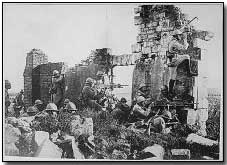Primary Documents - General German Statement on the Second Battle of the Marne, August 1918
 The
Second Battle of the Marne -
which ran from 15 July to 4 August 1918 - was intended as Germany's final
major attempt at breakthrough on the Western Front prior to the arrival of
ever-increasing U.S. troops on the battlefield.
The
Second Battle of the Marne -
which ran from 15 July to 4 August 1918 - was intended as Germany's final
major attempt at breakthrough on the Western Front prior to the arrival of
ever-increasing U.S. troops on the battlefield.
In the event the battle proved a significant Allied victory. Once it became clear that the Germans had not only failed in their aim to win the war in the offensive, but had in fact lost ground, a number of German commanders, including Crown Prince Wilhelm, believed the war was lost.
Reproduced below is the text of a semi-official statement issued by German General Baron von Ardenne on the outcome of fighting at the Marne, published in Germany in August 1918.
Click here to read General Gouraud's appeal to his forces at the onset of the battle. Click here to read an extract from U.S. Commander-in-Chief John J Pershing's official report summarising U.S. participation in the battle. Click here to read a German memoir focusing on the events of 15 July. Click here to read Pershing's Special Order of the Day, dated 27 August, in which he praised the role played by his forces. Click here to read another semi-official German press statement published in July 1918 on the outcome of fighting at the Marne. Click here and here to read contrasting statements regarding the effectiveness of the Allied counterattacks, issued by chief German strategist Erich Ludendorff. Click here to read the official address given by French General Charles Mangin on 7 August 1915, directed to U.S. First and Second servicemen who, assisting Mangin's French Tenth Army, participated in the Allied counter-attacks launched on 18 August. Click here to read the view later given by Mangin concerning the turning point of the Allied counterattack at the Marne. Click here to read the official address given by French Sixth Army General Jean Degoutte to French and U.S. troops towards the close of the battle, on 9 August 1918, in which he praised the conduct of American forces. Click here to read an account by Karl Rosner of how news of the battle was received by the Kaiser.
General Baron von Ardenne's Semi-official Statement, August 1918
Our three great battles of assault from March 21st to July 15th caused the enemy losses amounting to 1,225,000 men.
On July 15th our attempted surprise failed, and, despite his losses, the enemy's numerical superiority had increased. Then the German command, swift as lightning and without the least hesitation, knew how to find the transition to the now necessary, although momentary, defensive.
That was a strategic masterpiece which merits admiration. Moltke once said that the defensive could, under certain conditions, be the stronger form of combat, especially in sections of ground which are particularly favourable for defence and inaccessible to hostile enemy flanking attacks. There a numerically inferior force may compel superior enemy forces to costly frontal attacks.
The German command adopted this principle in its battles after July 15th.
Source: Source Records of the Great War, Vol. VI, ed. Charles F. Horne, National Alumni 1923
Both British and German fleets had around 45 submarines available at the time of the Battle of Jutland, but none were put to use.
- Did you know?
